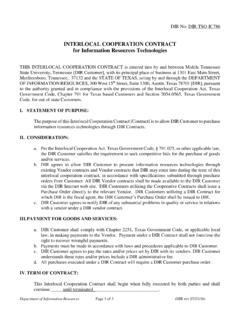Transcription of GPS Mapping of Stone Fences - Forest Hills, …
1 November 2007 Prepared for: City of Forest Hills 4012 Hillsboro Pike, Ste. 5 Nashville, tennessee 37215 GPS Mapping of Stone Fences City of Forest Hills, Davidson County, tennessee Prepared by: Zada Law, Thomas Nolan, , Director Fullerton Laboratory for Spatial Technology Department of Geosciences middle tennessee State university Murfreesboro, tennessee 37132 615-898-2726 GPS Mapping of Stone Fences in Forest Hills i y Management Summary During the summer of 2007, the staff of the Fullerton Laboratory for Spatial Technology at middle tennessee State university (MTSU) mapped the locations of Stone Fences in the City of Forest Hills, a small residential city in south-central Davidson County, tennessee .
2 The Mapping project was initiated at the request of Forest Hills Commissioner William Coke with the objective of developing a spatial database of Stone fence locations that could be used in municipal land use and development planning as well as conservation of this landscape feature. A differentially-corrected GPS unit was used to map location coordinates with a high degree of accuracy. The precision of the GPS-collected data was verified using high resolution color aerial imagery. The aerial imagery was also used to identify possible locations of other Stone fence remnants. The geospatial survey mapped 21, linear feet ( miles) of Stone fence segments. This total includes the previously-recorded segments inventoried in 2001 (Allen 2001) plus an additional 6, linear feet ( miles) of Stone fence segments recorded subsequent to the 2001 inventory, including a previously-unrecorded fence identified from color orthophoto imagery and verified by field-checking.
3 The GPS-mapped Stone Fences include over 11,207 linear feet ( miles) of Stone fence segments that do not appear on a fence and retaining wall digital data layer provided by Nashville s Metropolitan Planning Commission. To evaluate whether historic maps could be used to provide contexts for developing chronological indicators for Stone fence types for middle tennessee , the GPS-mapped Stone fence segments were overlaid on photocopies of the 1903 and 1932 Nashville, tennessee topographic quadrangles that had been scanned and georeferenced. While georeferencing is best done with scans of original maps to provide good spatial accuracy, this preliminary analysis suggests that historic topographic maps of the Forest Hills area could be useful in determining the ages of specific sections of Stone Fences , interpreting function and developing chronological sequences of Stone fence construction typologies.
4 Finally, a potential new Stone wall or fence subtype was identified by the survey. The type of Stone wall built along an intermittent tributary at 5906 Hillsboro Pike does not appear as a subtype in the Stone wall and fence categories proposed by Murray-Wooley and Raitz (1992) for the Lexington, Kentucky region. The Stone fence along the drainage may represent a new subtype of early twentieth century landscape element that can be added to the Murray-Wooley and Raitz model. GPS Mapping of Stone Fences in Forest Hills ii y Table of Contents Management Summary .. i Table of Contents .. ii Introduction .. 1 Background .. 1 Stone fence damage and loss .. 2 Conservation efforts in Forest Hills .. 2 Scope of work .. 3 Project Area.
5 3 Literature Review .. 3 Method .. 5 Assessing GPS coordinate accuracy .. 6 .. 7 Comparison of results with 2001 inventory .. 7 Identifying Stone Fences from aerial photos .. 8 Comparison of results with Metro Planning Commission fence inventory .. 11 Comparison of results with historic maps ..12 Stone fence types .. 14 Stone Fences along waterways .. 15 .. 17 Finding Stone Fences on aerial photos .. 17 fence conditions and construction patterns .. 18 Integration with historic and archaeological resource databases .. 18 . 19 Acknowledgments .. 20 References Cited .. 20 GPS Mapping of Stone Fences in Forest Hills iii y Figures 1.
6 City of Forest Hills, Davidson County, tennessee .. 1 2. Forest Hills project area .. 4 3. Results of GPS Mapping of Stone Fences in Forest Hills .. 8 4. Comparison of 2001 and 2007 Stone fence inventories .. 10 5. Example of potential and verified Stone fence locations from aerial photos .. 11 6. Comparison of GPS-mapped Stone fence locations with Metro Planning fence inventory ..12 7. Stone Fences in Forest Hills overlaid on 1903 topographic map.. 13 8. Stone Fences in Forest Hills overlaid on 1932 topographic map.. 13 9. Compton Cemetery, 1645 Tyne Boulevard .. 15 10. Stone walls along drainage, 5906 Hillsboro Pike .. 16 Tables 1. GPS-mapped fence segments .. 9 2. Comparison of fence lengths derived from 2001 inventory map with GPS-mapped lengths.
7 10 GPS Mapping of Stone Fences in Forest Hills 1 y GPS Mapping of Stone Fences City of Forest Hills, Davidson County, tennessee During the summer of 2007, the staff of the Fullerton Laboratory for Spatial Technology at middle tennessee State university (MTSU) mapped the locations of Stone Fences in the City of Forest Hills, a small residential city in south-central Davidson County, tennessee (Figure 1). The Mapping project was initiated at the request of Forest Hills Commissioner William Coke with the objective of developing a GIS (Geographic Information System) spatial data layer of Stone fence locations to incorporate into land use and development planning in the municipality. Accurate Mapping of Stone Fences would also assist in conservation of this landscape feature.
8 The MTSU team used Global ord the e to n Background Positioning System (GPS) technology to accurately reclocations of the Stone Fences in thfield and converted the GPS data into a digital geospatial technology was then usedoverlay the Stone fence location digital data layer on high resolution color aerial imagery to verify the accuracy of the GPS datacollection and identify possible locations of other Stone fence remnants. The Stone fence locations were also overlaid ohistoric maps to interpret relative age and function. Dry-stacked limestone Fences are common cultural landscape features along roadways, in pastures and unty, assistance to the stonemasons. enclosing cemeteries in the middle tennessee region. A popular perception is that Stone Fences in the southeastern United states were built by slaves prior to the Civil War.
9 However, research by Murray-Wooley and Raitz (1992) suggests that the eighteenth and nineteenth-century Stone Fences of the Bluegrass region around Lexington, Kentucky (approximately 200 miles northeast of Davidson CoTennessee) were, in fact, largely built by Irish and Scottish immigrants with slave labor providing Figure 1. City of Forest Hills, Davidson County, tennessee GPS Mapping of Stone Fences in Forest Hills 2 y Murray-Wooley and Raitz (1992:93-96) postulate that slaves working with Irish stonemasons in thnineteenth century learned stonee mid- fence building techniques from the Irish and continued to practice the masonry trade after emancipation. Investigations of Stone Fences in middle tennessee (Allen 2001; iddle tennessee s historic the modern ments involving ant nt also The City of Belle Meade, a small municipality in Davidson County, tennessee has repaired e ions ed to eason ills commissioned an inventory of extant was limited rest Hills.)
10 Layer that would accurately show the locations of known Stone Fences and integrate with other digital land Haynie 2000) also suggest that slaves in the Nashville region learned masonry techniques from Irish masons and eventually passed these techniques down through their families who carried on the traditionlocally. Stone fence damage and loss While Stone Fences are considered valuable assets in local communities, these vestiges of Mlandscape are, nonetheless, disappearing fromterrain. Residential and commercial developland-clearing, road-widening and utility construction are responsible for destroying or damaging many sections of extfences. Other Stone Fences , especially those situated on vacalots, have fallen into disrepair or have been robbed of Stone forother uses.










